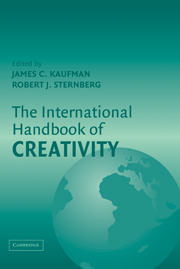Book contents
- Frontmatter
- Contents
- Acknowledgments
- List of Contributors
- 1 Introduction
- 2 Creativity Research in English-Speaking Countries
- 3 Creativity in Latin America
- 4 History of Creativity in Spain
- 5 Past, Present, and Future Perspectives on Creativity in France and French-Speaking Switzerland
- 6 Creativity in Italy
- 7 Creativity Research in German-Speaking Countries
- 8 Creativity Under the Northern Lights
- 9 Creativity in Soviet–Russian Psychology
- 10 Creativity Studies in Poland
- 11 Research on Creativity in Israel
- 12 Creativity in Turkey and Turkish-Speaking Countries
- 13 Development of Creativity Research in Chinese Societies
- 14 Creativity – A Sudden Rising Star in Korea
- 15 Culture and Facets of Creativity
- 16 African Perspectives on Creativity
- 17 Creativity Around the World in 80 Ways … but with One Destination
- Author Index
- Subject Index
- References
2 - Creativity Research in English-Speaking Countries
Published online by Cambridge University Press: 05 June 2012
- Frontmatter
- Contents
- Acknowledgments
- List of Contributors
- 1 Introduction
- 2 Creativity Research in English-Speaking Countries
- 3 Creativity in Latin America
- 4 History of Creativity in Spain
- 5 Past, Present, and Future Perspectives on Creativity in France and French-Speaking Switzerland
- 6 Creativity in Italy
- 7 Creativity Research in German-Speaking Countries
- 8 Creativity Under the Northern Lights
- 9 Creativity in Soviet–Russian Psychology
- 10 Creativity Studies in Poland
- 11 Research on Creativity in Israel
- 12 Creativity in Turkey and Turkish-Speaking Countries
- 13 Development of Creativity Research in Chinese Societies
- 14 Creativity – A Sudden Rising Star in Korea
- 15 Culture and Facets of Creativity
- 16 African Perspectives on Creativity
- 17 Creativity Around the World in 80 Ways … but with One Destination
- Author Index
- Subject Index
- References
Summary
INTRODUCTION
The Geography of Thought: How Asians and Westerners Think Differently, a new book by Richard Nisbett (2003), convincingly argues that culture influences cognition in powerful (and experimentally verifiable) ways. Nisbett doesn't discuss creativity – it isn't even listed in his fairly extensive index – but his general conclusions are probably as true for creativity as they are for the kinds of cognition he does discuss. He reports numerous studies showing that Western subjects and various groups of Asian subjects respond very differently to a wide range of cognitive tasks. The lesson for psychologists, he tells us in his conclusion, “is that, had the experiments in question been done just with Westerners, they would have come up with conclusions about perceptual and cognitive processes that are not by any means general” (p. 192).
We are pleased that the book of which this chapter is part will help to correct the myopia that can limit the vision of Western creativity researchers. Creativity research in the English-speaking world is such a large field that it is easy to forget that it is just one part of the larger creativity puzzle. The many other pieces of that puzzle can tell us a great deal about the larger picture of which the English-speaking piece is but a part. Creativity research can also teach us much about the English-speaking piece itself by allowing us to understand this research in context.
- Type
- Chapter
- Information
- The International Handbook of Creativity , pp. 10 - 38Publisher: Cambridge University PressPrint publication year: 2006
References
- 33
- Cited by



